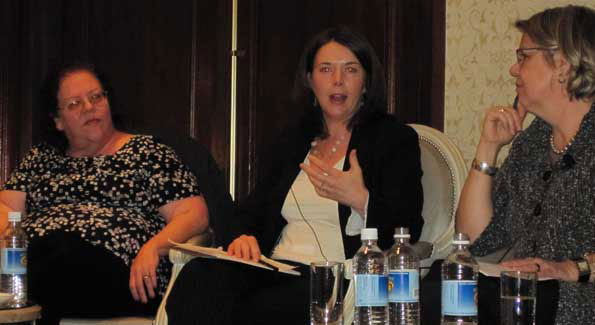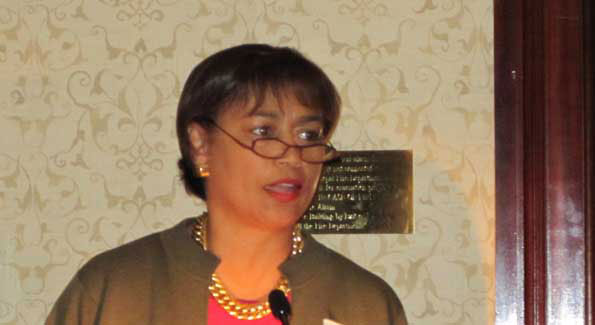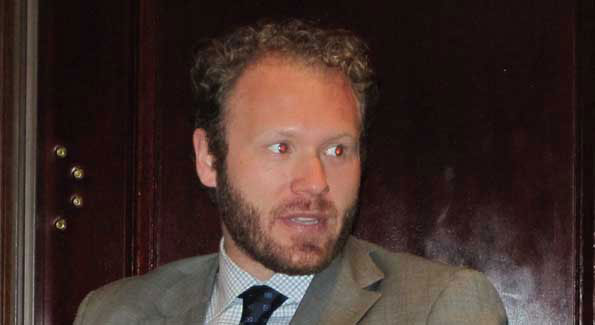The economy’s move south has changed attitudes and strategies in philanthropic planning. Stephen Thormahlen, Managing Director of PNC Wealth Management in Washington, DC, shared findings from their recent Wealth and Values Study. Clients now measure their wealth and assets more holistically and seek to use their wealth for causes that are meaningful to them. Eighty-eight percent of the survey respondents think it is now important to live within their means (Thormahlen hoped the other 12 percent already knew this), 66 percent better appreciate non-material wealth, and one-half percent feel more centered now after having re-established and re-evaluated their priorities.
Tamara Copeland, President of Washington Grantmakers, referenced their “Beyond Dollars” report to offer examples of how philanthropy extends past donations. She urged philanthropists to also use their influence to capitalize on timing and momentum (strike while the iron is hot), be a strong voice on issues for those who are unheard, leverage resources from their colleagues, government and business, and build partnerships to bring dissimilar people together for a common cause.
Eric Kessler, Principal and Founder of the Washington, DC Arabella Philanthropic Investment Advisors, identified four common elements among clients who have created high impact philanthropy. He urged philanthropists to involve themselves in policy advocacy, support grantees in creating a merger or alliance, align assets with the trustee’s mission, and help clients create public/private partnerships at the federal and local government level.
Improving the Washington, DC Schools
Kessler introduced panelists Katherine Bradley, President of CityBridge Foundation, and Justin Cohen, President of School Turnaround Strategy Group and former Senior Advisor to Chancellor Michelle Rhee of the District of Columbia Public Schools. Bradley and Cohen collaborated to transform 13 of Washington, DC’s public schools into 13 catalyst schools, with a launch date of September 2010. Each school will be redesigned around arts integration, world cultures or science, technology, engineering and math (STEM).
Cohen’s greatest need was research for the program aspect of the initiative. CityBridge lent Cohen their best practices research staff pro bono, and used the DC Public Education Fund to hire additional support staff, community organizers and to fund other program pieces. CityBridge also engaged their civic enterprise arm to support the branding and marketing part of the catalyst school transformation. Another benefit to the partnership, said Cohen, was that CityBridge offered Cohen a group of colleagues outside of the school system with whom we could discuss and exchange ideas.
Improving the Washington, DC Heath Care Delivery System
Sharon Baskerville , CEO of DC Primary Care Association (DCPCA); Margaret O’Bryon, President and CEO of Consumer Health Foundation; and Gina Lagomarsino, former Senior Health Policy Advisor to former Washington, DC Mayor Anthony Williams, collaborated to create Medical Homes DC to provide every underserved citizen of Washington, DC with an accessible and quality health care delivery system.

Sharon Baskerville, Gina Lagomarsino and Margaret O'Bryon teamed up to improve the district's health care delivery system (photo by Jane Hess Collins)
Prior to this partnership, the DC General Hospital had closed in 2001 and philanthropic funding of the district’s health care was piecemeal. Through strong, courageous and creative leadership, the partnership raised $70 million to expand health care services in 13 clinics, double the number of residents with primary health care access, complete six new clinics (five east of the Anacostia River) and increase net health care capacity by 30,000 visits.
The funding came from a variety of sources, including the city (contingent upon a 50 percent match by the DCPCA) and local and national funders. Baskerville estimated the total amount leveraged at over $100 million, primarily due to relationship-building and the in-depth analysis from the Brookings Institute and the RAND Corporation. That analysis, complete with color-coded maps and illustrations, gave funders a picture of the city’s health care demands and shortfalls.
Advice from the Experts
Relationships are primary and all else is derivative. “It doesn’t work unless there’s mutual respect and trust,” Cohen said. Be flexible and communicate. Stay involved. The relationships keep the momentum going, and if the partners change, the momentum may expire.
Partnerships can be messy. The private sector partner’s role isn’t easy to define or standardized. Be ready to make it up as you go.
Support the public partner. The private partner’s job is to ensure the success of the public partner, who sets the agenda and is ultimately accountable for the outcome. The private partner must focus on the big picture and avoid getting attached to specific parts of a project.
Pursue national funders and listen to local funders. Local foundations have more knowledge of the local issues and national funders typically have more money to give. The old belief that national funders can’t or won’t donate in the nation’s capitol seems to be changing, but they want matches and strong leadership before they will commit.
Build political will. Learn the issues thoroughly and clearly define and articulate them before approaching the philanthropic community.
Size doesn’t matter. A foundation of any size can make a significant difference if they can close the financial gap in an unmet need.
Attendees represented the Salvation Army, New York Times Knowledge Foundation, Diane and Norman Bernstein Foundation, World Bank Group, Washington Group, American Legacy Foundation, CareFirst, Community Foundation for the National Capitol Region, National Center for Responsive Philanthropy, Venture Philanthropy Partners, Mead Family Foundation, U.S. Chamber of Commerce, Morris & Gwendolyn Cafritz Foundation, Eugene & Agnes E. Meyer Foundation, Prince Charitable Trusts and the Tides Foundation.






